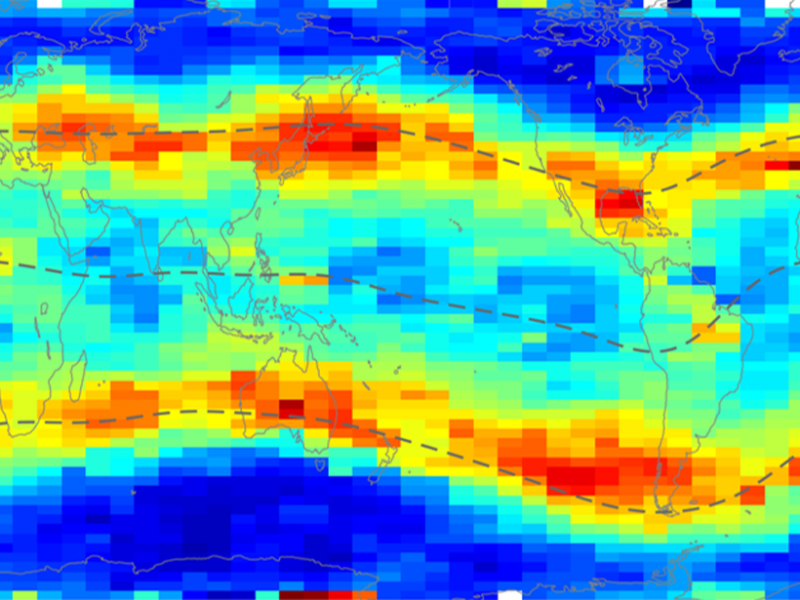Holistic Views of the Nighttime Ionosphere
The nightside ionosphere, at latitudes away from the auroral zone, should have very little charged particle density, but it doesn’t. A new comprehensive study of satellite data explains why.
SOURCE: Journal of Geophysical Research: Space Physics

Measurements from the COSMIC (Constellation Observing System for Meteorology, Ionosphere, and Climate) satellite of electron density at an altitude of 800 kilometers at 3 a.m. local time. The satellite orbital period is approximately 90 minutes, so, over the course of many orbits, all longitudes are sampled as the Earth rotates. The data was filtered for times near the March equinox during low magnetic activity times. It clearly shows the off-equatorial density peaks at ± 40 degrees magnetic latitude. Credit: Lei et al. [2019], Figure 1a
Without sunlight ionizing the upper atmosphere, one would think that the low-to-middle latitudinal nightside ionosphere would have very little charged particle density. This isn’t the case, though, and there are bands of density at approximately 40 degrees north and south magnetic latitude in the topside ionosphere (seen figure above).
A new study of electron data from the COSMIC satellite by Lei et al. [2019] has revealed the systematic properties of these density bands, and their variation with season and solar activity. With their careful analysis of this robust set of observations, they conclude that the charged particle density is maintained by the convergence of two flows – a downward flow of charge particles from the plasmasphere and an upward push from upper atmospheric winds. This keeps the charged particles at a high altitude and shelters them from recombination processes at lower altitudes. At certain times and places, the density is actually higher than it would be at that location when on the dayside.
Citation: Zhong, J., Lei, J., Yue, X., Luan, X., & Dou, X. [2019]. Middle‐latitudinal band structure observed in the nighttime ionosphere. Journal of Geophysical Research: Space Physics, 124.https://doi.org/10.1029/2018JA026059
—Mike Liemohn, Editor-in-Chief, JGR: Space Physics
最新国外工作学习机会
1. Oceanography Tenure-Track Faculty
College Station, Texas
Texas A&M University Oceanography Department
https://findajob.agu.org/job/8009726/oceanography-tenure-track-faculty/?LinkSource=PremiumListing
2. PhD Student in Soil Hydrology
Rehovot, Israel
Hebrew University of Jerusalem
https://findajob.agu.org/job/8010869/phd-student-in-soil-hydrology/
3. Professorship (m/f/d) in Radiation and Remote Sensing of Atmospheres
Berlin (DE)
W 2 (limited appointment for five years)
Freie Universität Berlin
4. Professor/Chair Geological Sciences
Reno, Nevada (US)
Professor - Rank IV
University of Nevada Reno - Department of Geological Sciences and Engineering (DSGE)
https://findajob.agu.org/job/8010866/professor-chair-geological-sciences/



